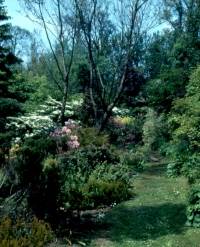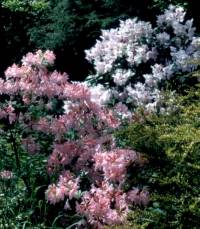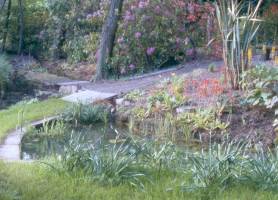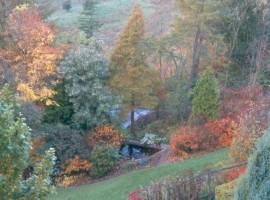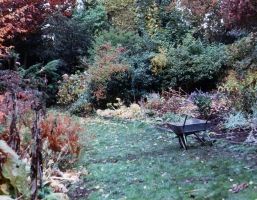Our garden slopes down towards the North Esk River, just south of Edinburgh, and faces
south-west. The top of the slope is well-drained sand, but the underlying clay emerges
at the bottom of the garden, so that is permanently wet. We are therefore able to grow a
huge range of plants in a small area.
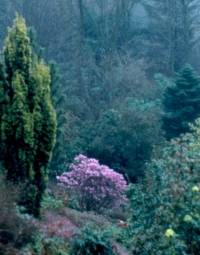

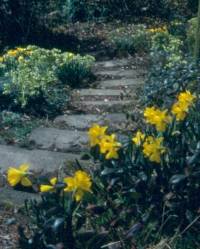

We know that spring will come when we see the luminous glow of
Rhododendron
'Praecox' brightening a dreary winter day.
The garden is full of bulbs, and every year we increase the range of varieties.


It is beautiful in every season.
History of the garden
Kevock Garden was first planted over 40 years ago. The major development was done by
Sir John Randall,
an enthusiastic horticulturalist, but best known for his invention of the
cavity magnetron
(the widget that makes both radar and your domestic microwave cooker possible), and for
being head of the department in which
Maurice Wilkins
and Rosalind Franklin
did their work on the structure of DNA. His scientific skill was shown by his botanical
choices. His early plantings of trees are now mature, giving structure and form, and
many of the rhododendrons, magnolias and camellias are substantial, flowering profusely
in early summer.

 At 77 he was unable to cope with the steep slope, and in 1983 we moved in. We reclaimed
treasures from the undergrowth, and then, with a particular interest in rare alpines,
started to build rockeries, terracing parts of the slopes. Many of the first plants were
grown from seeds from the
Scottish Rock Garden Club
and Alpine Garden Society
but now we draw on many sources, testing introductions in the garden. Here are some of
them in the greenhouse.
At 77 he was unable to cope with the steep slope, and in 1983 we moved in. We reclaimed
treasures from the undergrowth, and then, with a particular interest in rare alpines,
started to build rockeries, terracing parts of the slopes. Many of the first plants were
grown from seeds from the
Scottish Rock Garden Club
and Alpine Garden Society
but now we draw on many sources, testing introductions in the garden. Here are some of
them in the greenhouse.
A wonderful view
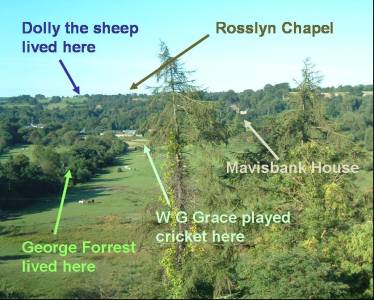

Our garden overlooks the valley of the North Esk, just south of Edinburgh, facing
Mavisbank House, an Adam mansion dating from 1730, and featured on the Restoration
TV series. At the far end of the Mavisbank grounds we see what was a cricket ground in the nineteenth century. There was a rumour that W G Grace played there, but there doesn't seem to be any documentary evidence for this. On the skyline we can just see
Rosslyn Chapel, now sadly
better known as the site of the climax of the
Da Vinci Code,
rather than for its spectacular and unusual architecture. Across the fields to the left
is the Roslin Institute,
where Dolly the sheep and her cloned siblings were manufactured and spent their lives.
And down by the River Esk is Glenkevock House, where the plant collector
George Forrest lived after his first expedition to China.
The house


Our house is an early
Morris and Steedman design, which featured in a programme
as part of a BBC4 series,
Living with Modernism, in Spring 2006. It is at the top of the slope, and it is like
living in a tree house, as we look down on the kestrels hovering over the field
below.
Garden open
We open every year as part of the
Scotland's Gardens programme
and, by appointment only, to groups. We have also featured on
Beechgrove Garden
and articles have appeared in many newspapers and magazines, including Scotland on Sunday,
The Scottish Garden, The Northern Garden, The Scotsman, Guardian, Financial Times, Glasgow Herald and
Daily Telegraph.
Plant stalls are available when the garden is open, when we give talks about the garden, the nursery and our expeditions, and at various flower shows.
What happened to our weeds?
We have very interesting weeds. Plants multiplied dramatically in the garden and we found
seedlings of unusual plants in the paths and lawns. There were branches to be pruned and
clumps to be split. We didn't have the heart to throw things away, so we started to pot
up our oddments to sell to visitors to the garden - and that is how Kevock Garden Plants
was born. And then it grew - and grew. You can see the present
nursery site development, which
started in 2002. Now there is a
team of people working with us.
Kevock Garden Design was started to provide a comprehensive
service to those who want to have interesting planting schemes, with colour in all
seasons, in their own gardens.


